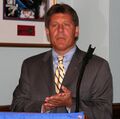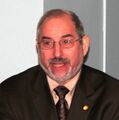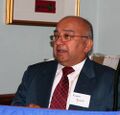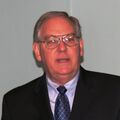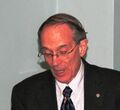Milestones:Thomas A. Edison West Orange Laboratories and Factories, 1887
- Date Dedicated
- 2008/10/18
- Dedication #
- 76
- Location
- West Orange, NJ
- IEEE Regions
- 1
- IEEE sections
- North Jersey
- Achievement date range
- 1887
Thomas A. Edison West Orange Laboratories and Factories, 1887
Thomas Alva Edison, a West Orange resident from 1886 until his death in 1931, established his final and most comprehensive laboratory and factory complex about one-half mile (0.8 km) north of here in 1887. Edison's visionary combination in one organization of basic and applied research, development, and manufacturing became the prototype for industrial enterprises worldwide. Work here resulted in more than half of Edison's 1,093 patents.
The IEEE Milestone plaque can be viewed about .7 km south in front of the West Orange City Hall on Main St. & Mt. Pleasant Ave., 40.778479, -74.239051
Throughout his legendary career, Edison sought inventions that had practical commercial application and which would improve the quality of people’s lives. His vision of establishing an “invention factory” to pursue new developments in a comprehensive and organized manner was given birth at his earlier laboratories in Newark and Menlo Park, NJ, U.S.A..
While some of Edison’s most creative work took place at Menlo Park between 1876 and 1884, his pioneering approach to the process of invention and development came to full fruition with the opening of the West Orange, NJ laboratory complex in 1887. The facilities were well equipped with many kinds of machinery and instruments, were fully supplied with materials from around the world, and were well staffed by dedicated and carefully-chosen workers.
Moreover, the West Orange location allowed Edison easy access to his financial backers in New York City and provided comprehensive rail and other transportation services. Edison was able to purchase enough land in West Orange to build factories in close proximity to the laboratory complex to permit the prompt and efficient mass production and commercialization of perfected inventions and improved products.
Edison engaged in research and development in many varied fields of endeavor during his 44 years of work at the West Orange complex. Indeed, more than half of the 1,093 patents issued to Edison during his career related to work done in West Orange. Important inventions related specifically to electrical engineering developed and manufactured by Edison and his staff at the West Orange facilities include:
1) A continually improved phonograph, first demonstrated at Menlo Park in 1877 but largely set aside while Edison worked on the first practical and commercially successful incandescent light bulb and his direct current electric utility systems.
2) The development of motion picture cameras, viewers and projectors, including the Kinetoscope, the Kinetograph and the Projectoscope. Edison also worked on synchronizing sound and motion pictures some twenty years before the advent of “talkies.” Edison produced many motion pictures at West Orange, including the first one ever copyrighted. To facilitate the making of motion pictures, Edison designed and built the first motion picture studio, commonly referred to as the “Black Maria,” in 1893. The studio could be rotated on tracks and the roof opened so that the best natural light could be obtained for a given scene. Demolished in 1903 after Edison moved motion picture production to New York, a full-size replica of the “Black Maria” was built at the laboratory site in 1954.
3) Development, over a period of ten years, of an improved storage battery that offered significant advantages over the then-standard lead-acid battery. After thousands of experiments, Edison’s nickel-iron-alkaline battery was finally perfected in 1909. This storage battery found wide use and became the standard in applications calling for a rugged and dependable battery offering long life. Uses have included power plant standby sources, railroad signals, miner’s lamps, and marine and military applications. Moreover, the vast quantity of carefully recorded empirical data accumulated by Edison during his decade-long effort to perfect his storage battery has provided a wealth of data and knowledge for later generations of battery researchers.
4) Invention of an early fluoroscope as a medical diagnostic tool. An Edison fluoroscope was used in the first x-ray operation in the United States.
Dedication ceremony
Supporting Materials
- "Thomas A. Edison recognized in IEEE Milestone Event", by Michael Miller, PES Regional Representative for Regions 1 & 2 - article about the Milestone ceremony, containing some of the photographs in the photo gallery above
- exterior of Milestone dedication ceremony program
- interior of Milestone dedication ceremony program
References
R. W. Clark, Edison, The Man Who Made The Future. New York: Putnam’s Sons, 1977.
R. Conot, A Streak Of Luck. New York: Seaview Books,1979.
P. Israel, Edison: A Life of Invention. New York: John Wiley & Sons, Inc., 1998.
M. Josephson, Edison. New York: McGraw-Hill Book Company, Inc., 1959.
B. McCormick and P. Israel, Underrated Entrepreneur, Thomas Edison’s Overlooked Business Story. IEEE Power & Energy Magazine, vol. 3, no. 1, pp 76-79, Jan./Feb. 2005.
A. Millard, Edison and the Business of Invention. Baltimore, MD: The Johns Hopkins University Press, 1990.
J. D. Ryder and D. G. Fink, Engineers and Electrons: A Century of Electrical Progress. New York: IEEE Press, 1984.
C. L. Sulzberger. An Early Road Warrior, Electric Vehicles in the Early Years of the Automobile. IEEE Power & Energy Magazine, vol. 2, no. 3, pp 66-71, May/June 2004.
Edison, a brochure made available by the U. S. National Park Service at the Edison National Historic Site, West Orange, NJ., no. 491-282/40196, GPO 2002.
Thomas Alva Edison and Electric Power Engineering, a booklet prepared for the Edison sesquicentennial, IEEE Power Engineering Society, 1997.
Map







